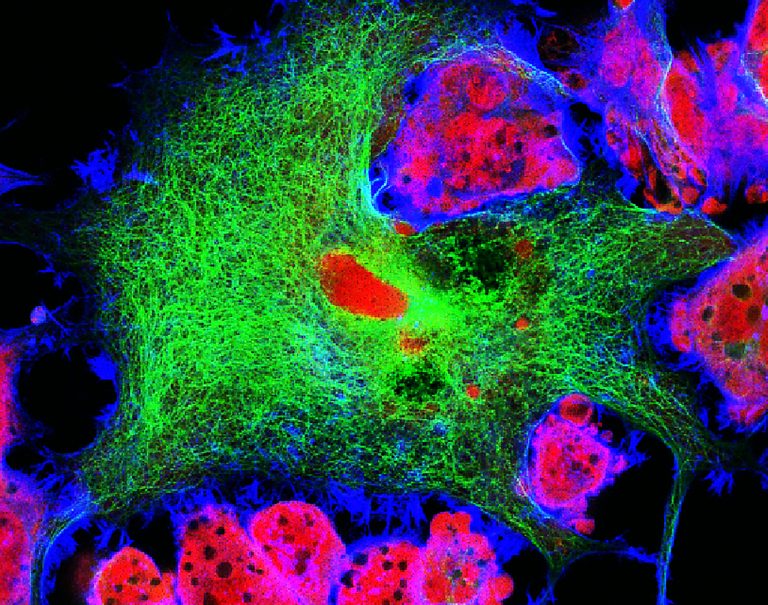
Researchers from the Wellcome Sanger Institute, Great Ormond Street Hospital (GOSH), and the Princess Máxima Center for Pediatric Oncology, have unveiled new research indicating that all neuroblastomas arise from a single type of embryonic cell, known as sympathoblasts, which could point to new therapeutic options. The discovery that all neuroblastomas arise from sympathoblasts makes these cells an attractive drug target, because they exist only in the tumor after the child is born.
Through what they claim is the largest single cell study of neuroblastoma carried out to date, researchers from the Wellcome Sanger Institute, Great Ormond Street Hospital (GOSH), and the Princess Máxima Center for Pediatric Oncology, have found the answers to important questions about the genesis of this childhood cancer. Their results indicate that all neuroblastomas arise from a single type of embryonic cell, known as sympathoblasts, which could point to new therapeutic options. The discovery that all neuroblastomas arise from sympathoblasts makes these cells an attractive drug target, because they exist only in the tumor after the child is born.
Reporting on the findings in Science Advances, which the team claim is the largest single cell study of neuroblastoma carried out to date, senior author Karin Straathof, Ph.D., from Great Ormond Street Hospital, said, “Neuroblastoma is an unusual cancer in that some tumors resolve without intervention, yet the disease still has one of the lowest five-year survival rates of any childhood cancer. This study fills important gaps in our knowledge of what neuroblastoma cells are and revealed novel treatment targets. My hope is that new, less intrusive therapies can be developed by targeting sympathoblasts, a developmental cell type that exists only in neuroblastoma tumors after a child is born.”
Straathof and colleagues described their findings in a paper titled, “Tumor to normal single-cell mRNA comparisons reveal a pan-neuroblastoma cancer cell.”
Neuroblastoma is a rare cancer that generally affects children under five years old. It begins in the abdomen, usually in the adrenal glands. One remarkable feature of neuroblastoma is that its severity can vary greatly between individuals. In some children, the cancer will disappear without treatment, whereas in others the cancer is relentless. The five-year survival rate for neuroblastoma remains one of the lowest of all childhood cancers.
Straathof and colleagues were interested in understanding why neuroblastomas range in severity to such a degree, and wanted find out whether this difference between patients could be caused by neuroblastomas arising from different cell types at different stages of the child’s development in the womb. “Different stages of adrenal medullary cell differentiation have been implicated as the cell of origin of neuroblastoma, and proposed to underlie the diversity of clinical phenotypes,” they wrote.
For their studies, the team took advantage of single-cell mRNA sequencing, a high-resolution technology that can identify different cell types present in a tissue according to the genes expressed by individual cells. “ … we sought to establish, through cancer to normal single-cell mRNA comparisons, which developmental processes and cell types neuroblastoma recapitulates and correlate our findings with disease phenotypes,” the authors continued.
They analyzed gene expression in 19,723 cancer cells, which they compared with a reference set of 57,972 developmental adrenal cells, in the hope of identifying the cell types from which neuroblastomas arise, and potentially identify novel treatment targets. The major finding from the analyses was that neuroblastoma cancer cells resembled fetal sympathoblasts, “and no other fetal adrenal cell type,” the authors commented. “The sympathoblastic state was a universal feature of neuroblastoma cells, transcending cell cluster diversity, individual patients, and clinical phenotypes … Overall, our observations indicate that a pan-neuroblastoma cancer cell state exists, which may be attractive for novel immunotherapeutic and targeted avenues.”
Co-senior study author Jan Molenaar, PhD, from the Princess Máxima Center for Pediatric Oncology in the Netherlands, further noted, “What is most striking about our findings is that despite the great diversity of clinical behavior of neuroblastoma, there is an overarching neuroblastoma cell type that is found in all patients. The identification of sympathoblasts as the root of all neuroblastoma is an important step towards understanding how the disease develops and, hopefully, how we can treat it.”
Many cancer treatments can cause serious side effects, but in recent years, technological advances have allowed researchers to identify differences in biological processes—and in gene expression—between healthy, and cancerous human cells. These differences can feasibly be exploited to attack cancer cells without affecting the patient’s healthy cells. The presence of sympathoblasts, a developmental cell type not normally found in children after they are born, makes it a promising drug target for the treatment of neuroblastoma.
“Overall, our findings reveal an unexpected homogeneity in the cellular identity of neuroblastoma,” the team concluded. “Although future, larger-scale analyses may define the nuances of this signal and perhaps identify rare cancer cell types, our study would suggest that the principal normal cell correlate of neuroblastoma is the human fetal sympathoblast.”
As well as facilitating the discovery of sympathoblasts as the root of neuroblastoma, the single-cell reference map of the developmental adrenal gland will also contribute to the Human Cell Atlas project. The project aims to create comprehensive reference maps of all types of human cells—the fundamental units of life—as a basis for understanding human health and diagnosing, monitoring, and treating disease.
Sam Behjati, Ph.D., a co-senior author of the study from the Wellcome Sanger Institute and Cambridge University Hospitals, noted, “Our study shows the power of looking at individual childhood cancer cells in revealing not just one, but a plethora of novel treatment ideas. This raises the exciting prospect that a single cell atlas of all types of pediatric tumors may transform our understanding of childhood cancer.”













